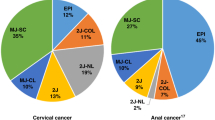The presence of virus DNA integration into the cell genome was studied for 47 primary HPV16-positive patients with morphologically verified stage III cervical cancer. By using ROC analysis, the patients were divided into two groups: with and without HPV DNA integration into the host cell genome. The differences between the groups by the histological type, degree of tumor differentiation, and primary response to therapy were statistically insignificant. Virus DNA integration more than 7-fold reduced 5-year relapse-free survival and 1.7-fold reduced overall survival rate in comparison with patients without HPV DNA integration (p=0.0002 and p=0.05, respectively). The relative risk of adverse outcome of the disease in patients with the presence of HPV16 DNA integration increases by 4 times over a period of less than 3 years (р=0.0006) at high AUC level. The probability of earlier progression of the disease in patients with of HPV DNA integration calculated according to the Cox proportional hazards model was 85.5% (hazard ratio 5.96; p=0.002). Thus, the results suggest that the presence of HPV16 DNA integration into the cell genome is an independent factor in predicting clinical outcome of advanced cervical cancer and can serve as an effective criterion for the individual choice of treatment tactics for the patients.
Similar content being viewed by others
References
Malignant Neoplasms in Russia in 2016 (Morbidity and Mortality). Kaprin AD, Starinskii VV, Petrova GV, eds. Moscow, 2018. Russian.
Kiseleva VI, Krikunova LI, Mkrtchan LS, Lyubina LV, Bezyaeva GP, Panarina LV, Saenko AS, Zamulaeva ІA. The significance of physical status of human papillomavirus type 16 for predicting the effectiveness of invasive cervical cancer treatment. Vorp. Onkol. 2013;59(6):756-760. Russian.
Rumyantsev PO, Saenko VA, Rumyantseva UV, Chekin SYu. Statistical methods for the analyses in clinical practice. Part 2. Survival analysis and multivariate statistics. Porbl. Endocrinol. 2009;55(6):48-56. Russian.
Akagi K, Li J, Broutian TR, Padilla-Nash H, Xiao W, Jiang B, Rocco JW, Teknos TN, Kumar B, Wangsa D, He D, Ried T, Symer DE, Gillison ML. Genome-wide analysis of HPV integration in human cancers reveals recurrent, focal genomic instability. Genome Res. 2014;24(2):185-199.
FUTURE I/II Study Group, Dillner J, Kjaer SK, Wheeler CM, Sigurdsson K, Iversen OE, Hernandez-Avila M, Perez G, Brown DR, Koutsky L.A, Tay EH, García P, Ault KA, Garland SM, Leodolter S, Olsson SE, Tang GW, Ferris DG, Paavonen J, Lehtinen M, Steben M, Bosch FX, Joura EA, Majewski S, Muñoz N, Myers ER, Villa LL, Taddeo FJ, Roberts C, Tadesse A, Bryan JT, Maansson R, Lu S, Vuocolo S, Hesley TM, Barr E, Haupt R. Four year efficacy of prophylactic human papillomavirus quadrivalent vaccine against low grade cervical, vulvar, and vaginal intraepithelial neoplasia and anogenital warts: randomised controlled trial. BMJ. 2010;341. c3493. doi: https://doi.org/10.1136/bmj.c3493.
Huang SS, Hao DZ, Zhang Y, Liu HM, Shan WS. Progress in studies of the mechanisms and clinical diagnosis of cervical carcinoma associated with genomic integration of high-risk human papillomavirus DNA. Yi Chuan. 2017;39(9):775-783.
Kim JY, Park S, Nam BH, Roh JW, Lee CH, Kim YH, Shin HJ, Lee SK, Kong SY, Seong MW, Han TJ, Lee MY, Cho KH, Park SY. Low initial human papilloma viral load implicates worse prognosis in patients with uterine cervical cancer treated with radiotherapy. J. Clin. Oncol. 2009;27(30):5088-5093.
Li H, Yang Y, Zhang R, Cai Y, Yang X, Wang Z, Li Y, Cheng X, Ye X, Xiang Y, Zhu B. Preferential sites for the integration and disruption of human papillomavirus 16 in cervical lesions. J. Clin. Virol. 2013;56(4):342-347.
Li P, Tan Y, Zhu LX, Zhou LN, Zeng P, Liu Q, Chen MB, Tian Y. Prognostic value of HPV DNA status in cervical cancer before treatment: a systematic review and meta-analysis. Oncotarget. 2017;8(39):66 352-66 359.
Lindel K, Rieken S, Daffinger S, Weber KJ, de Villiers EM, Debus J. The transcriptional regulator gene E2 of the Human Papillomavirus (HPV) 16 influences the radiosensitivity of cervical keratinocytes. Radiat. Oncol. 2012;7:187. doi: https://doi.org/10.1186/1748-717X-7-187.
Shin HJ, Joo J, Yoon JH, Yoo CW, Kim JY. Physical status of human papillomavirus integration in cervical cancer is associated with treatment outcome of the patients treated with radiotherapy. PLoS One. 2014;9(1). E78995. doi: https://doi.org/10.1371/journal.pone.0078995.
Vozenin MC, Lord HK, Hartl D, Deutsch E. Unravelling the biology of human papillomavirus (HPV) related tumours to enhance their radiosensitivity. Cancer Treat. Rev. 2010;36(8):629-636.
Author information
Authors and Affiliations
Corresponding author
Additional information
Translated from Byulleten’ Eksperimental’noi Biologii i Meditsiny, Vol. 168, No. 7, pp. 100-105, July, 2019
Rights and permissions
About this article
Cite this article
Kiseleva, V.I., Mkrtchyan, L.S., Ivanov, S.A. et al. The Presence of Human Papillomavirus DNA Integration is Associated with Poor Clinical Results in Patients with Third-Stage Cervical Cancer. Bull Exp Biol Med 168, 87–91 (2019). https://doi.org/10.1007/s10517-019-04654-2
Received:
Published:
Issue Date:
DOI: https://doi.org/10.1007/s10517-019-04654-2




